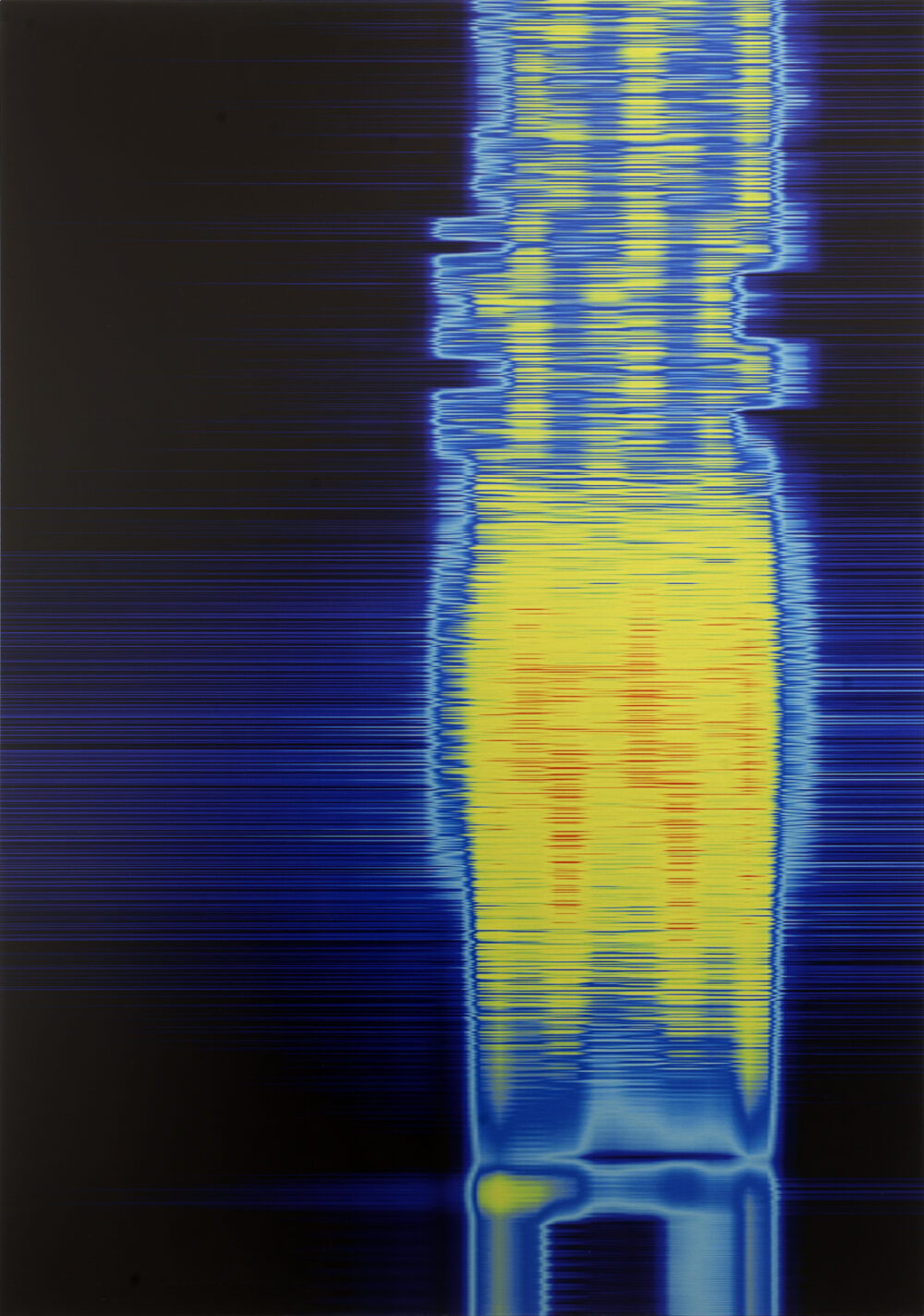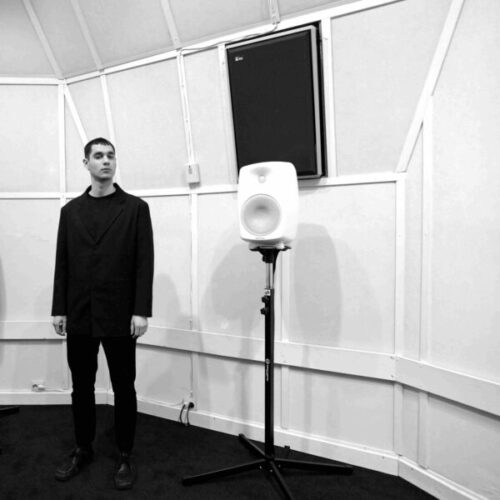The Final Transcript: Manos Saklas (OTOLITHS IN FLUX)

Otoliths in Flux is a 1-hour long, monthly podcast/radio show by Manos Saklas from Athens. Manos is exploring emerging sonic art territories through artist talks, discussions and thematic radio pieces, hosting diverse yet influential present-day artists, theorists and composers.
Since 2021, Manos has hosted Jessica Ekomane, Marcus Schmickler, Eleni Ikoniadou, Marcin Pietruszewski, Felicia Atkinson and many more.
“highlighting the collective aspects of artistic creation and hopefully creating a sense of community”
Please tell me a little bit about how music became a part of your life.
I was drawn to music from a very young age and picked up the electric guitar during primary school.
I think I started listening to electronic music around my early teens, getting heavily inspired by Greek artists like “Stereo Nova”, and the Warp Classics from the 90s and later on discovering labels like Editions Mego. Listening to this kind of music moved me and informed my whole perspective on art and aesthetics. I eventually bought a KORG MS-20 when I turned 18 and immediately fell in love with synthesis and sound composition.
When did you have the first idea to produce OIF and how was the road to the first episode?
Otoliths in Flux was conceived on the occasion of Movement Festival in 2020, a festival exploring human mobility in the Mediterranean, from the interwar period to the present. For this, I performed A Mediterranean Genealogy of Noise’, A sonic fiction mapping the wide spectrum of “noise” practices that took place within the Mediterranean and beyond: from the early experiments of the Italian Futurists and Halim El Dabh at the beginning of the century, to present-day sonic territories by Fransisco López and Rashad Becker among others.

Why did you choose this specific format?
I was originally commissioned to make a three-hour sound collage performance for Movement Festival because at that time I was working with sound archives. I ended up approaching these performances and radio pieces as formats with aesthetic potential, and not as something that was heading towards entertainment.
However, the artist talk series started when I first met Jacob Kirkegaard in Athens. The whole idea came through a discussion we had on the piece he was recording at that time for Borderline Festival.
I was particularly interested in the context in which he operates as an artist – participating in contemporary art exhibitions while presenting sound pieces in concert halls and experimental music festivals.
At this point, I thought that a series of talks could bring together artists whose work deals with certain themes, highlighting the collective aspects of artistic creation and hopefully creating a sense of community.
Can you briefly touch on who Onassis Stegi is and Movement Radio and how you got involved with them?
Onassis Stegi is a cultural foundation that has a long-standing relationship with contemporary music and sound practices among other fields of art. Stegi’s Borderline Festival has been taking place annually since 2011 and has introduced numerous sound artists and electroacoustic music composers to the Greek audience, while Stegi Radio is an online platform exploring cross-cultural interactions and politico-theoretical discourse through thematic radio pieces, mixtapes, podcasts and artist talks.
Stegi Radio is curated by DETACH: a collective of two artists and curators – Voltnoi and Quetempo – whose practice features a research-heavy approach that employs text, sound, and moving image.
I met the duo at a group show we both participated in in 2019, where I exhibited a sound installation that caught their attention. Soon we discovered that we also shared an interest in the relationship between art and technology in a broader sense and that was the start of a long-term collaboration.

“The show focuses on interdisciplinary practices that are centered around sound”
Tell me about your decision process behind selecting the topics/artists.
The show focuses on interdisciplinary practices that are centered around sound, featuring artists and theorists who touch on extra-musical themes related to notions such as noise, materiality, and listening. All of the participating artists deal with these topics in their work and Otoliths in Flux offers a platform for these ideas to be discussed.
In general, I have no particular interest in art forms that are characterised by a set of rules or formulas, like songwriting and “fine arts” in the traditional sense. This is reflected in the show, as I tend to invite artists with backgrounds as diverse as visual art, philosophy, design, media theory, film, and politics among other disciplines.
How did you end up in this specific area of interest?
My aesthetic interests have gradually developed during the past decade through my life as an artist, my personal life, my studies, the places I’ve lived, nightlife, and so on… All these different aspects have informed the way I think, yet I feel like my “taste” has been surprisingly consistent throughout the years. Perhaps my interests have evolved in such an organic way that I can’t trace the changes…
How did the podcast change over time and how would you like it to evolve?
The artist talk series has slightly changed during the past two years, as my attention has shifted towards artistic practices that are associated with computational aesthetics, psychoacoustics, noise theory, and the voice among other things. Nevertheless, I always try to broaden the framework within which I operate, without losing the essence of those core themes.
I think about Otoliths in Flux as a digital platform with a solid curatorial direction and I’m quite happy with the form it has taken so far, even though I’m sure it will evolve toward new territories over time.
How do you personally consume music journalism? What are your favourite outlets these days?
I’m not sure if I am interested in “music journalism”, and I’d rather avoid this term when it comes to Otoliths in Flux.
That said, I enjoy reading Shilla Strelka’s writings, reflecting her unique listening perspective and her overall great taste. Ina Blom and Eleni Ikoniadou’s brilliant books and articles have also been a great source of inspiration for me. I’ve been returning to their work now and then.
I know that you are very interested in Xenakis. What’s your relationship with his work?
My interest in Xenakis has emerged from several random events. I studied at the Contemporary Music Research Center (CMRC) – an electroacoustic music studio founded by Xenakis in 1979. When I arrived there in 2017 the place looked like a time capsule, left completely untouched with dusty Xenakis posters on the walls, a Greek-labelled UPIC sitting around the studio, and the legendary EMS Synthi 100 which had just been brought back to life for Documenta 14.
Although Xenakis is a well-known figure internationally, his work remains fairly inaccessible and so it was for my 19-year-old self. It was during my studies at CMRC and EMS Elektronmusikstudion that I developed a deeper understanding of his work and became aware of the weight of his contribution to contemporary art and music composition. Xenakis’ synthetic and synaesthetic modernism offered a transdisciplinary approach to sound that can be still traced in the work of present-day artists such as Marcus Schmickler, Stine Janvin, and Marcin Pietruszewski. Naturally, his visual, computational, and overall sophisticated compositional methods have been a recurring theme on the show…
“the multimodal nature of listening and synthetic sound”

You just finished your diploma as a sound and visual artist. Please tell us about your artistic work and how it’s informed by your work as a journalist.
My artistic practice concerns the multimodal nature of listening and synthetic sound, along with themes related to notions such as noise, materiality, and the voice. I primarily work with computer-generated images and visual manifestations of oscillatory phenomena, while my compositional work focuses on the psychoacoustic properties of synthetic sound, and process-based composition.
In solo exhibition contexts, I construct listening spaces where individual entities coexist presenting visual works, text, and sound pieces as a whole. My latest exhibition titled “Articulations of Chaos” featured a 30-minute auditory drama I composed during my residency at EMS, accompanied by a new series of visual works and a text written by Eleni Ikoniadou.
Considering that Otoliths in Flux now features more than 20 artist talks, the process of selecting the artists, the themes of discussion, and the overall curatorial dimension has been a substantial input for my artistic practice.
How does the city of Athens relate to yourself and your work as a journalist/artist?
Growing up in Athens is a particularly defining experience, due to Greece’s geographical location and all the troubles and the by-products that come with being in the middle – In the Mediterranean. Greece’s chronic political unrest, the vibrant Athenian art scenes and countercultures have probably shaped me more than I can grasp. I think that one could even trace these qualities in several artists and intellectuals originating from here – Xenakis being a fine example.
Regarding the city’s contemporary art and sound/music scene, some brilliant artists and theorists live and work here, such as Athanasios Argianas, Eleni Ikoniadou, George Moraitis, and ILIOS among other dear friends.
Thanks much for the interview!
Thanks for having me!

Manos Saklas
This article is brought to you by Struma+Iodine as part of the EM GUIDE project – an initiative dedicated to empowering independent music magazines and strengthen the underground music scene in Europe. Read more about the project at emgui.de
Funded by the European Union. Views and opinions expressed are however those of the author(s) only and do not necessarily reflect those of the European Union or the European Education and Culture Executive Agency (EACEA). Neither the European Union nor EACEA can be held responsible for them.